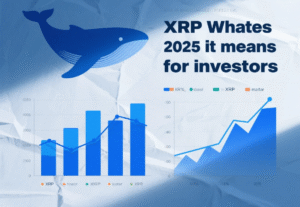Savvy traders never pay full fees. Use these referral codes to save for life: Binance WZ9KD49N / OKX 26021839

From 2020 to 2022, crypto projects swam in cash, fueled by venture capital (VC), token sales, and airdrops during a roaring bull market. Fast forward to 2025, and the funding landscape has shifted dramatically—capital is scarce, and crypto treasuries are feeling the pinch. But could this tightening be a blessing in disguise? This article explores why the end of the easy money era might push the crypto industry toward sustainability, forcing projects to prioritize real value over hype.

What Was the ‘Easy Money’ Era?
High-Valuation Funding in the Bull Market
- During the 2020–2022 crypto boom, projects raised billions through VC investments and token presales, often at sky-high valuations.
- Examples: Solana raised $314 million in 2021, and Axie Infinity secured $152 million at a $3 billion valuation.
DAOs and Protocol Treasuries Flush with Cash
- DAOs like Uniswap and Aave amassed treasuries worth hundreds of millions, holding ETH, BTC, and governance tokens.
- Large treasuries funded aggressive expansion, grants, and community incentives, often without clear revenue plans.
Misuse of Funds and Unsustainable Models
- Many projects burned cash on marketing, bloated teams, or speculative ventures with little ROI.
- Lack of sustainable business models led to overreliance on token price appreciation.
Side Effects of Speculative Capital Inflows
- Short-term speculators drove token prices to unsustainable highs, inflating treasury valuations.
- This fueled hype cycles but left projects vulnerable when market sentiment turned.
Why the Easy Money Era Ended
Macro Environment: Rate Hikes and Liquidity Crunch
- Central banks, including the Federal Reserve, raised interest rates in 2023–2025, tightening global liquidity.
- Higher borrowing costs made speculative VC investments in crypto less attractive.
Investor Caution
- After high-profile failures (e.g., FTX collapse in 2022), VCs and retail investors grew wary of crypto’s risks.
- Focus shifted to projects with proven revenue and fundamentals, per CoinDesk reports.
Rising Regulatory Pressure
- Stricter regulations in the U.S., EU (MiCA), and Asia increased compliance costs for crypto projects.
- KYC/AML requirements and tax scrutiny deterred speculative funding.
Bear Market and Treasury Value Erosion
- The 2022–2023 bear market slashed token prices (e.g., ETH down ~60% from its 2021 peak).
- DAO treasuries, heavily weighted in native tokens, saw their USD value plummet, forcing budget cuts.
The Impact on Crypto Treasuries
Treasury Asset Shrinkage
- Many treasuries, holding ETH, BTC, or governance tokens, lost 30–70% of their value since 2021 peaks.
- Example: Aave’s treasury dropped from $500 million in 2021 to ~$200 million by mid-2025, per DeFiLlama.
Cost-Cutting and Financial Restructuring
- DAOs and protocols slashed grants, marketing, and team sizes to preserve runway.
- Example: MakerDAO reduced community grants by 40% to focus on core operations.
Focus on Fund Management and Transparency
- Projects adopted stricter treasury management, with tools like Gnosis Safe and multisig wallets for accountability.
- Transparency reports became standard to rebuild community trust.
Shift from “Burning Cash” to “Value Creation”
- Protocols moved away from growth-at-all-costs models, prioritizing sustainable revenue streams.
- Emphasis on user fees, staking rewards, and real-world asset (RWA) yields.
Why This Could Be Good for Crypto
Finding Real Revenue Streams
- Projects are now forced to develop sustainable income, such as transaction fees, RWA yields, or service-based revenue.
- Example: Uniswap generates ~$2 billion annually in swap fees, per Token Terminal.
Improving Capital Efficiency
- Tighter budgets reduce wasteful spending on overhyped marketing or unproven projects.
- Protocols optimize resources, focusing on high-impact development.
Incentivizing Long-Term Product Development
- Leaner funding pushes teams to build durable, user-focused products rather than chasing quick pumps.
- Example: Optimism’s focus on scalable Layer-2 solutions over speculative airdrops.
Heightened Investor and Community Scrutiny
- Investors and communities now demand financial health, pushing projects toward accountability.
- This maturity signals a shift from speculative frenzy to a professionalized industry.
Case Studies
DeFi Protocols Investing in RWAs
- MakerDAO allocated ~$500 million of its treasury to tokenized U.S. Treasuries and bonds via Centrifuge, yielding stable returns.
- This diversifies risk and aligns with the growing RWA trend (market cap ~$76 billion in 2025).
Layer-2 Projects Refining Fee Models
- Arbitrum and Optimism optimized gas fee structures to boost treasury revenue, reducing reliance on token sales.
- Example: Arbitrum’s sequencer fees generated $50 million in 2024, per Dune Analytics.
DAO Dissolutions and Survival of the Fittest
- Underfunded DAOs with no revenue (e.g., some NFT projects) dissolved, weeding out weak players.
- Surviving protocols, like Curve, focused on core functionality and community governance.
Future Outlook
Forcing Profitability Paths
- Funding constraints will push Web3 projects to find viable revenue models faster, such as fee-based services or RWA yields.
- Example: Chainlink’s CCIP generates cross-chain revenue, bolstering its treasury.
RWAs, Stablecoin Yields, and On-Chain Tools
- Treasuries will increasingly diversify into tokenized Treasuries, stablecoin staking, and DeFi yield farming.
- Stable assets like USDC and tokenized bonds offer predictable returns, reducing volatility risk.
VC Focus on Fundamentals
- VCs will prioritize projects with strong fundamentals, like proven revenue or real-world adoption, per Bloomberg.
- Early-stage funding may shrink, but quality projects will attract larger rounds.
A Shift to Healthy Growth
- The industry is moving from bubble-driven expansion to sustainable growth, mirroring tech’s dot-com bust recovery.
- This could lay the foundation for a more resilient crypto ecosystem by 2030.
Conclusion
The end of the easy money era for crypto treasuries marks a pivotal shift from wild growth to disciplined sustainability. Tighter funding is forcing projects to prioritize real revenue, efficient capital use, and transparency—a necessary de-foaming process that strengthens the industry’s resilience. As we head toward the next bull market, will crypto treasuries emerge leaner, smarter, and more sustainable? The answer depends on how projects adapt to this new reality.
FAQ
What Is a Crypto Treasury?
A crypto treasury is a project or DAO’s reserve of assets (e.g., ETH, BTC, governance tokens) used to fund operations, grants, and development.
Why Did the Easy Money Era in Crypto End?
Rate hikes, investor caution, regulatory pressures, and a bear market slashed token values and funding availability by 2025.
How Are DAOs Managing Treasuries in 2025?
DAOs are cutting costs, investing in RWAs, and adopting transparent tools like Gnosis Safe to preserve funds.
Why Could Tighter Funding Be Good for Crypto?
It forces projects to find sustainable revenue, reduce waste, and build long-term value, maturing the industry.




